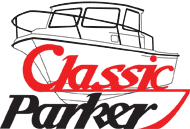SBH2OMan
Well-known member
Hopefully I'll be trialing a 2320 this weekend; I'm a novice boater and have trialed three or four other boats during my 18-month long search for the right one (this will be the first Parker, and I really hope the seller accepts my final offer). The trial will probably occur before haul-out, survey, and mech inspection just due to logistics. (BTW, other boats fell through because of poor handling or mechanical problems identified during survey)
It is a '93 equipped with a later model OX66 (250) on narrow style Armstrong bracket.
I've noticed with three guys in the cockpit (I weigh 160, the other weighs 175 and the third maybe 180) water burbles in and out of the ping-pong ball style scuppers. From what I read here, that is not uncommon (but its without the bait tank full) The boat lives in the water, so the scuppers have covers, but there is a lot of algae on the covers and around the bases of the scuppers - I'm hoping that the water is coming in just because the balls aren't sealing... The hull is remarkably clean and well-maintained.
Anyway, in past sea trials, I have taken boats through the no-wake zone to see how low-speed handling feels, then getting a few miles outside the harbor entrance to head up-swell, down swell, cross-swell (usually in 2-3' wind swell). I'll run up to typical cruise speed for a while in all directions, crossing my wake a few times. I'll play with the trim tabs to see if they get the nose up or down depending on conditions. I'll then do some hard turns to see how she behaves under "emergency" situations (cavitation, general handling). This boat has an analog GPH gauge (with a small LCD at the bottom which I assume shows total gallons consumed since reset), so I'll also be noting fuel economy. I'll also usually find a safe shallow spot to drop anchor then retrieve anchor just to see how she sits at anchor.
Is there anything else that you long term Parker owners recommend that I check during a sea trial?
Thanks in advance for all the help. I'm definitely hoping this is "the one" but I'm still waiting to hear back from the seller on my final offer.... (fingers crossed)....
Thanks in advance,
It is a '93 equipped with a later model OX66 (250) on narrow style Armstrong bracket.
I've noticed with three guys in the cockpit (I weigh 160, the other weighs 175 and the third maybe 180) water burbles in and out of the ping-pong ball style scuppers. From what I read here, that is not uncommon (but its without the bait tank full) The boat lives in the water, so the scuppers have covers, but there is a lot of algae on the covers and around the bases of the scuppers - I'm hoping that the water is coming in just because the balls aren't sealing... The hull is remarkably clean and well-maintained.
Anyway, in past sea trials, I have taken boats through the no-wake zone to see how low-speed handling feels, then getting a few miles outside the harbor entrance to head up-swell, down swell, cross-swell (usually in 2-3' wind swell). I'll run up to typical cruise speed for a while in all directions, crossing my wake a few times. I'll play with the trim tabs to see if they get the nose up or down depending on conditions. I'll then do some hard turns to see how she behaves under "emergency" situations (cavitation, general handling). This boat has an analog GPH gauge (with a small LCD at the bottom which I assume shows total gallons consumed since reset), so I'll also be noting fuel economy. I'll also usually find a safe shallow spot to drop anchor then retrieve anchor just to see how she sits at anchor.
Is there anything else that you long term Parker owners recommend that I check during a sea trial?
Thanks in advance for all the help. I'm definitely hoping this is "the one" but I'm still waiting to hear back from the seller on my final offer.... (fingers crossed)....
Thanks in advance,












![601-Piece Fishing Gear Accessories Kit, [2025 NEW] Tackle Box with Pliers, Fish Lip Grips,Tackle Storage Trays, Hooks, Weights, Jig Heads, Swivels, 21 Pre-Made Rigs – Fishing Gear for Lures Fishing](https://m.media-amazon.com/images/I/51xjl+HLdhL._SL500_.jpg)

